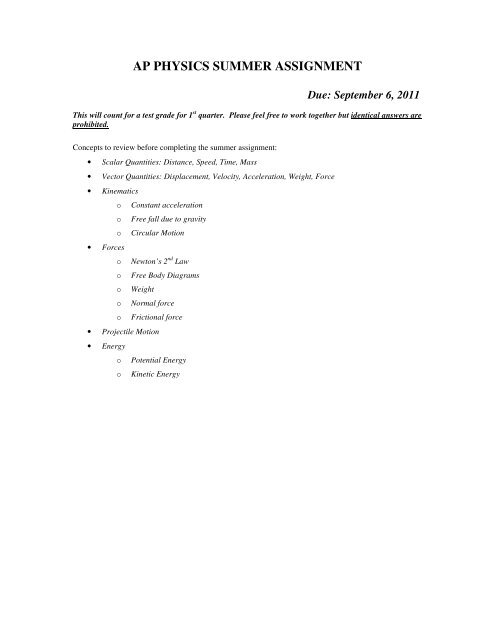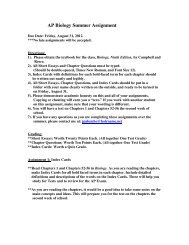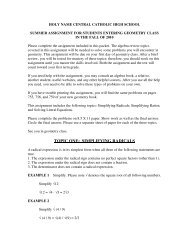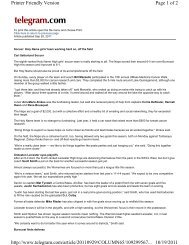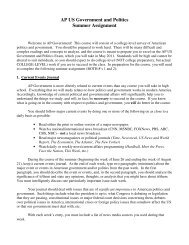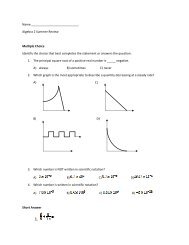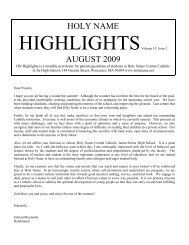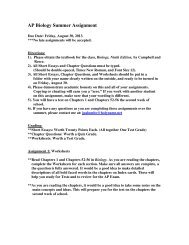AP PHYSICS SUMMER ASSIGNMENT
AP PHYSICS SUMMER ASSIGNMENT
AP PHYSICS SUMMER ASSIGNMENT
Create successful ePaper yourself
Turn your PDF publications into a flip-book with our unique Google optimized e-Paper software.
<strong>AP</strong> <strong>PHYSICS</strong> <strong>SUMMER</strong> <strong>ASSIGNMENT</strong><br />
Due: September 6, 2011<br />
This will count for a test grade for 1 st quarter. Please feel free to work together but identical answers are<br />
prohibited.<br />
Concepts to review before completing the summer assignment:<br />
• Scalar Quantities: Distance, Speed, Time, Mass<br />
• Vector Quantities: Displacement, Velocity, Acceleration, Weight, Force<br />
• Kinematics<br />
o Constant acceleration<br />
o Free fall due to gravity<br />
o Circular Motion<br />
• Forces<br />
o Newton’s 2 nd Law<br />
o Free Body Diagrams<br />
o Weight<br />
o Normal force<br />
o Frictional force<br />
• Projectile Motion<br />
• Energy<br />
o Potential Energy<br />
o Kinetic Energy
1. The graph above shows the velocity versus time for an object moving in a straight line. At what time<br />
after<br />
t = 0 does the object again pass through its initial position<br />
(A) Between 0 and 1 s (B) 1 s (C) Between 1 and 2 s (D) 2s (E) Between 2 and 3 s<br />
Questions 2 - 3<br />
A 2-kilogram block slides down a 30° incline as shown above with an acceleration of 2 meters per second<br />
squared.<br />
2. Which of the following diagrams best represents the gravitational force W. the frictional force f, and<br />
the normal force N that act on the block<br />
4. The magnitude of the frictional force along the plane is most nearly<br />
(A) 2.5 N (B) 5 N (C) 6 N ( D) 10 N ( E) 16 N<br />
5. A body moving in the positive x direction passes the origin at time t = 0. Between t = 0 and t = 1<br />
second, the body has a constant speed of 24 meters per second. At t = 1 second, the body is given a<br />
constant acceleration of 6 meters per second squared in the negative x direction. The position x of the<br />
body at t = 11 seconds is<br />
(A) +99m (B) +36m (C) - 36 m (D) - 75 m (E) - 99 m<br />
6. The displacement x of an object moving along the x-axis is shown above as a function of time t. The<br />
acceleration of this object must be<br />
(A) zero (B) constant but not zero (C) increasing (D) decreasing (E) equal to g<br />
7. An object is released from rest on a planet that has no atmosphere. The object falls freely for 3.0<br />
meters in the first second. What is the magnitude of the acceleration due to gravity on the planet<br />
(A) 1.5 m s 2 (B) 3.0 m/s 2 (C) 6.0 m/s 2 (D) 10.0 m/s 2 (E) 12.0 m/s 2
8. A uniform rope of weight 50 newtons hangs from a hook as shown above. A box of weight 100<br />
newtons hangs from the rope. What is the tension in the rope<br />
(A) 50 N throughout the rope (B) 75 N throughout the rope (C) 100 N throughout the rope<br />
(D) 150 N throughout the rope (E) It varies from 100 N at the bottom of the rope to 150 N at the top.<br />
9. A truck traveled 400 meters north in 80 seconds, and then it traveled 300 meters east in 70 seconds.<br />
The magnitude of the average velocity of the truck was most nearly<br />
(A) 1.2 m/s (B) 3.3 m/s (C) 4.6 m/s (D) 6.6 m/s (E) 9.3 m/s<br />
10. An automobile moves at constant speed down one hill and up another hill along the smoothly curved<br />
surface shown above. Which of the following diagrams best represents the directions of the velocity<br />
and the acceleration of the automobile at the instant that it is at the lowest position. as shown<br />
(A)<br />
a<br />
v<br />
(B)<br />
a<br />
v<br />
(C)<br />
v<br />
a<br />
(D)<br />
v<br />
a<br />
(E)<br />
a<br />
v<br />
A plane 5 meters in length is inclined at an angle of 37°, as shown above. A block of weight 20 newtons is<br />
placed at the top of the plane and allowed to slide down.<br />
11. The mass of the block is most nearly<br />
(A) 1.0 kg (B) 1.2 kg (C) 1.6 kg (D) 2.0 kg (E) 2.5 kg<br />
12. The magnitude of the normal force exerted on the block by the plane is most nearly<br />
(A) 10 N (B) 12 N (C) 16 N (D) 20 N (E) 33 N<br />
13. The work done on the block by the gravitational force during the 5-meter slide down the plane is most<br />
nearly<br />
(A) 20 J (B) 60 J (C) 80 J (D) 100 J (E) 130 J
FR1. ( 15 points)Part of the track of an amusement park roller coaster is shaped as shown above. A safety<br />
bar is oriented lengthwise along the top of each car. In one roller coaster car, a small 0.10-kilogram ball is<br />
suspended from this bar by a short length of light, inextensible string.<br />
a. Initially, the car is at rest at point A.<br />
i. On the diagram below, draw and label all the forces acting on the 0.10-kilogram ball.<br />
ii. Calculate the tension in the string.<br />
The car is then accelerated horizontally, goes up a 30° incline, goes down a 30° incline, and then goes<br />
around a vertical circular loop of radius 25 meters. For each of the four situations described in parts (b) to<br />
(e), do all three of the following. In each situation, assume that the ball has stopped swinging back and<br />
forth. 1)Determine the horizontal component T h of the tension in the string in newtons and record your<br />
answer in the space provided. 2)Determine the vertical component T v of the tension in the string in<br />
newtons and record your answer in the space provided. 3)Show on the adjacent diagram the approximate<br />
direction of the string with respect to the vertical. The dashed line shows the vertical in each situation.<br />
b. The car is at point B moving horizontally 2 to the right with an acceleration of 5.0 m/s .<br />
T h =<br />
T v =<br />
c. The car is at point C and is being pulled up the 30° incline with a constant speed of 30 m/s.<br />
T h =<br />
T v =
d. The car is at point D moving down the incline with an acceleration of 5.0 m/s 2 .<br />
T h =<br />
T v =<br />
e. The car is at point E moving upside down with an instantaneous speed of 25 m/s and no tangential<br />
acceleration at the top of the vertical loop of radius 25 meters.<br />
T h =<br />
T v =
FR2. A 0.50 kg cart moves on a straight horizontal track. The graph of velocity v versus time t for the cart<br />
is given below.<br />
a. Indicate every time t for which the cart is at rest.<br />
b. Indicate every time interval for which the speed (magnitude of velocity) of the cart is increasing.<br />
c. Determine the horizontal position x of the cart at t = 9.0 s if the cart is located at x = 2.0 m at t = 0. d.<br />
On the axes below, sketch the acceleration a versus time t graph for the motion of the cart from t = 0 to<br />
t = 25 s.<br />
e. From t = 25 s until the cart reaches the end of the track, the cart continues with constant horizontal<br />
velocity. The cart leaves the end of the track and hits the floor, which is 0.40 m below the track.<br />
Neglecting air resistance, determine each of the following:<br />
i. The time from when the cart leaves the track until it first hits the floor<br />
ii. The horizontal distance from the end of the track to the point at which the cart first hits the floor<br />
iii. The kinetic energy of the cart immediately before it hits the floor


